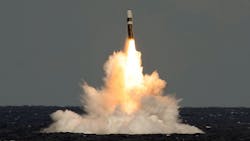Draper Lab focuses on inertial guidance upgrades to Navy Trident II submarine-launched ballistic missiles
WASHINGTON – Missile navigation experts at the Charles Stark Draper Laboratory Inc. in Cambridge, Mass., will design and build inertial guidance system components for upgrades to the U.S. Navy submarine-launched Trident II (D5) nuclear missile under terms of a $161.1 million order.
Draper Lab will provide design analysis, testing, procurement, and manufacturing of circuit card assemblies, interferometric fiber optic gyros, and accelerometers for upgrades to Trident II missile guidance systems.
These upgrades involve the Trident ballistic missile inertial measurement units, electronic assemblies, electronic modules, and guidance system components. These upgrades are part of the missile's Strategic Systems Program Alteration (SPALT) of MK6 MOD I guidance systems.
Draper Lab is designing a new boost guidance system for the Trident II missile to keep the nuclear weapon system operating through at least 2042. The company is replacing inertial measurement units, electronic assemblies, electronic modules and mission-critical flight and shipboard-test software for the Trident submarine fleet.
Related: Lockheed Martin to upgrade submarine inertial navigation
These new systems upgrades are designed to fit into the space within the missile used by the previous system, and Draper engineers modified radiation-hardened technologies to withstand the rigors of the strategic missile application.
Draper is using a modular design approach that allows simultaneous development of several solutions for higher-risk components, such as gyroscopes. Draper engineers have adapted commercial technologies such as fiber-optics for gyroscopes and magnetoresistive memory.
The contract modification for this job was awarded in February by the Navy Strategic Systems Programs in Washington. Draper will do the work in Cambridge and Pittsfield, Mass; Clearwater, Fla.; and East Aurora, N.Y., and should be finished by July 2025.
For more information contact Draper Lab online at www.draper.com, or the Navy Strategic Systems Programs office at www.ssp.navy.mil.
About the Author
John Keller
Editor-in-Chief
John Keller is the Editor-in-Chief, Military & Aerospace Electronics Magazine--provides extensive coverage and analysis of enabling electronics and optoelectronic technologies in military, space and commercial aviation applications. John has been a member of the Military & Aerospace Electronics staff since 1989 and chief editor since 1995.
